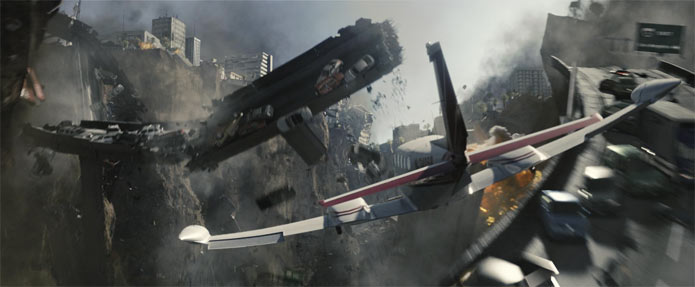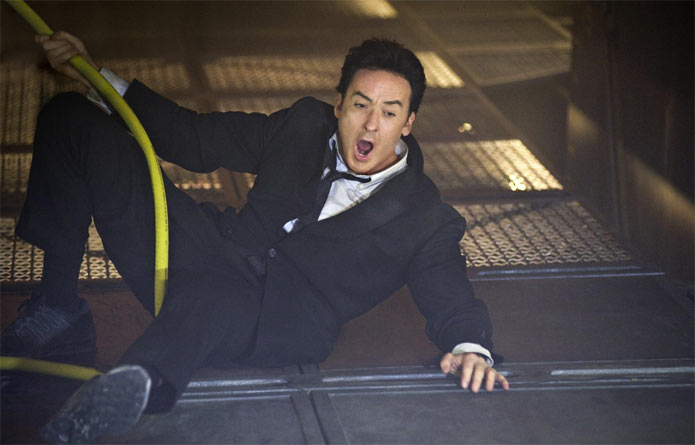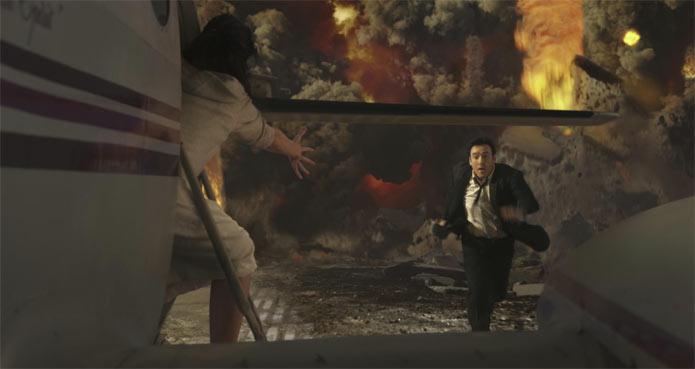
2012

 – for intense disaster sequences and some language.
– for intense disaster sequences and some language.
Director: Roland Emmerich
Starring: John Cusack, Amanda Peet, Danny Glover, Oliver Platt
Running Time: 2 hours, 40 minutes
Theatrical Release Date: November 13, 2009

Plot Summary
Never before has a date in history been so significant to so many cultures, so many religions, scientists, and governments. “2012” is an epic adventure about a global cataclysm that brings an end to the world and tells of the heroic struggle of the survivors.
When sci-fi writer Jackson Curtis takes his kids on a camping trip to Yellowstone Park, he discovers that the national landmark has been turned into a mysterious government headquarters that a local fanatic believes is a significant location for the beginning of a worldwide catastrophe. When all mayhem eventually breaks loose, the Curtis family begin a race against the clock to find a way to escape certain doom.
Film Review
While director Roland Emmerich isn’t exactly known for making Oscar-worthy films (unless you’re taking the special effects category into consideration), Emmerich’s name has become associated closely with the disaster film genre. In 1996, Emmerich’s name was put on the map with the Will Smith starring alien attack movie, Independence Day, which showcased a great deal of the disaster destruction in the process. He followed it up with the remarkably cheesy and altogether embarrassing attempt to relaunch the Godzilla franchise in 1998. Emmerich then took a break from the overblown destruction genre to do the Mel Gibson war film, The Patriot in 2000, before returning with the politically correct global warming disaster film, The Day After Tomorrow in 2004. Last year, he took audiences back to prehistoric times with the silly 10,000 BC, and returns once more to the disaster film with what he claims will be his last for the genre, the end-all 2012.

Sometimes you have to wonder why an actor or actress accepts a role. Most of Emmerich’s films can boast a pretty good cast, whether it’s been Smith, Gibson, Dennis Quaid, Jeff Goldblum, Jake Gyllenhaal, Kurt Russell, or Matthew Broderick. 2012 isn’t much different as he enlists the talents of John Cusack, Amanda Peet, Thandie Newton, Danny Glover, Oliver Platt, and Woody Harrelson. Cusack, who has usually been pretty choosey with his roles, opting for more adult-oriented dramas or comedies or more independent films over the years, adds a little more appeal to 2012 before it even begins considering the actor usually plays pretty fun or intriguing characters. However, as can be expected, Emmerich doesn’t give Cusack a whole lot to work with. When the movie opens, we find that Cusack’s Jackson Curtis lives on his own and is heading out to Yellowstone Park with his estranged children, Noah and Lily. Emmerich seems to rely heavily on family tensions to let the disaster aspects unite the family. It’s something we’ve seen throughout many films in the genre, actually, whether it’s been Spielberg’s War Of The Worlds, Emmerich’s Day After Tomorrow, Poseidon, or Deep Impact, and it’s something that’s sort of become as expected and typical to the genre as giant sequences of destruction. It adds drama to the story, but because these movies always incorporate completely random characters that the central ones meet along the way, trying to develop each one enough to justify their existence in the movie tends to leave everyone relatively flat and underwritten. It’s to the point where if a character dies, the only reason why you might care is because you like the actor or actress playing them or are mildly concerned for what other characters they might be leaving behind. So Cusack and Peet are interesting and “charming” enough to make their characters decent central ones, but even Cusack seems like he wants to do more but doesn’t have the right, or enough, material to work with. We know from the bits and pieces of character development we’re given that Cusack’s Jackson is a failed sci-fi writer who apparently was divorced by his wife because he spent more time working than with his family. We’re not given much else other than that, so we’re mostly left to fill in the blanks with our imagination.
With its almost three-hour runtime, you might expect 2012 to be some kind of sweeping epic with incredible music, story, characters, and action sequences. But if you know Emmerich’s work, none of those would come into play. While everything about 2012 is an improvement upon The Day After Tomorrow, it’s still B-movie material at its best. Oliver Platt is your stereotypical self-centered governmental baddie who apparently thinks all religious people – especially Christians – are mindless fools, and Emmerich tends to hint in all of his films that he feels the same way. One moment of destruction shows the Sistine Chapel crumbling and falling forward (which, the physics alone of the sequence doesn’t really look sensical), while people are earnestly praying all around it. But before it crumbles, we the classic painting on the ceiling inside and a crack that spreads across the ceiling distinctly, prominently going right between the fingers of Adam and God. And after some incongruous or moronic dialog about Nietzsche and the Bible in Day After Tomorrow, stuff like this can be expected from Emmerich. In fact, the film’s most fun character is an end-of-the-world fanatic played by Woody Harrelson who seems to support some Christian end times beliefs. Of course, Emmerich would paint such a character as a complete loon. But overall, aside from the Sistine Chapel crack and some random bits of dialog, Emmerich at least focuses on most of the world’s major religions and how they might come into play during the end of the world, instead of singling out the Christian faith alone. In the end, 2012 seems to lean a bit more on an absence of religion or a slightly neutral stance (by not praising one over another), than just focusing heavily on trying to discredit one altogether (that’s not to excuse Emmerich’s choice in direction).
The content is mostly what you could expect from a disaster film. There’s an incredible amount of destruction across the globe, causing millions, perhaps billions of deaths. We see people falling into chasms or off cliffs, vehicles with people in them crashing or crashing and exploding, people crushed by falling objects, huge tsunamis, etc. It’s pretty overwhelming despite some of it looking less than convincing. The idea of such mass destruction is disturbing, and for some it may be alarming especially since it takes place in the not so distant future. Language is pretty rough at times too. Although it doesn’t feel as frequent being that it’s spread over almost three hours, Jackson does mouth the “f” word in the beginning of the film and blatantly exclaim it in panic a little while later. There’s a handful of “s” words and mild obscenities (mainly “h*ll”), while at least 4 or 5 uses of “g*dd*mn” are included, as well as almost twenty derivatives of “G-d” (like “Oh G-d,” “Oh my G-d,” and “My G-d”) as exclamations. Finally, two uses of Jesus’ name and one of “Jesus Christ” are also used. It’s unneeded and offensive, so I don’t know why it was deemed necessary for the film. Lastly, there’s a little bit of blood scattered throughout the film, but surprisingly not much. We see a little bit on a fallen pilot and around his head, and later a person’s leg gets wounded and we briefly see the bloody wound underneath a torn pant leg a couple times. That’s really the extent of it, however.

The effects range from stunning to pathetic. Most of the time it’s the former, thankfully, but there are several moments, like when the characters are just standing in a dust cloud in “Las Vegas” that it’s more than obviously green screen work. It’s the kind of glaringly obvious poor effects that made Australia so appaulingly bad. Otherwise, most of the buildings crumbling and streets cracking are pretty impressive. An earthquake that ravages a Los Angeles supermarket is pretty poorly done as well, but when a cruise liner gets hit by a large wave, it’s on par with – or even more nicely done than – 2006’s Poseidon. But effects do not a good movie make, and most of the close calls our heroes encounter just seem insanely silly. Whether it’s someone surviving a vehicle going off a cliff by them somehow climbing out of it at the last second and dangling on the edge of the gigantic sink hole, or it’s a limousine surviving being pursued by a gigantic earthquake with overwhelming destruction following them only inches away, 2012 is just terribly implausible at times. Perhaps if it didn’t take itself otherwise so seriously most of the time, it would actually be more fun, but instead, it’s one of those movies that’s just begging to be spoofed. It’s a shame too, because with the right writers, actors, direction, and effects, a movie like 2012 could have
been really a lot more memorable and enjoyable. Instead, it’s reduced to more guilty pleasure and bargain bin shopping than anything better.
2012 is ultimately the disaster movie of all disaster movies. Forcefully directed by Roland Emmerich, this end of the world destruction fest lacks on many levels, while ultimately delivering in entertainment for those easily pleased or, at least, not expecting much. It’s violent with an incredibly high death toll racked up, and you can expect to see many characters we meet along the way fall to their deaths, get crushed, or even drown. It’s a gruesome movie without being graphically explicit, and one you won’t be wanting to take the kids to. While the film does take itself way too seriously, it ultimately is one of those movies that are so cheesy and bad that you can enjoy them under the right mindset, but in the end, you’re likely to be left with the sinking feeling that although you moderately enjoyed the experience, it could have – and should have – been so much better.
– John DiBiase, (reviewed: 11/15/09)
Parental Guide: Content Summary
![]() Sex/Nudity: Jackson takes the kids on a hike in Yellowstone and he says to them that he wanted to show them where he and their mom used to go on a hike. His son Noah remarks that he doesn’t want to know where his parents had sex; Gordon hugs Kate from behind in the grocery store and she pushes him off. He complains to her that she gets like that when Jackson comes around and remarks that women pay him thousands of dollars to touch their boobs but she gets to have it for free (he’s a surgeon); Laura shows some cleavage in the movie; A man comments to his girlfriend that he knows she was cheating on him
Sex/Nudity: Jackson takes the kids on a hike in Yellowstone and he says to them that he wanted to show them where he and their mom used to go on a hike. His son Noah remarks that he doesn’t want to know where his parents had sex; Gordon hugs Kate from behind in the grocery store and she pushes him off. He complains to her that she gets like that when Jackson comes around and remarks that women pay him thousands of dollars to touch their boobs but she gets to have it for free (he’s a surgeon); Laura shows some cleavage in the movie; A man comments to his girlfriend that he knows she was cheating on him
![]() Vulgarity/Language: 1 “f” word (and possibly one mouthed); 2 “J-sus,” 1 “J-sus Chr-st,” 5 “g*dd*mn,” 6 “s” words, 11 “h*ll,” 1 “d*mn,” 3 “a” word, 6 “b*stard,” 1 “sucks” (written); 1 “For Chr-st’s sake,” at least 17 derivatives of “G-d;” a woman gives a man “the finger”
Vulgarity/Language: 1 “f” word (and possibly one mouthed); 2 “J-sus,” 1 “J-sus Chr-st,” 5 “g*dd*mn,” 6 “s” words, 11 “h*ll,” 1 “d*mn,” 3 “a” word, 6 “b*stard,” 1 “sucks” (written); 1 “For Chr-st’s sake,” at least 17 derivatives of “G-d;” a woman gives a man “the finger”
![]() Alcohol/Drugs: Charlie drinks beer in his trailer and gives some to Jackson; A man decides to have a drink on an ocean liner after hearing the world was coming to an end. His friend scolds him for drinking after “25 years on the wagon.” We later see the same man drinking, go to take another sip, realize he shouldn’t, and just put the glass down.
Alcohol/Drugs: Charlie drinks beer in his trailer and gives some to Jackson; A man decides to have a drink on an ocean liner after hearing the world was coming to an end. His friend scolds him for drinking after “25 years on the wagon.” We later see the same man drinking, go to take another sip, realize he shouldn’t, and just put the glass down.
![]() Blood/Gore: The Curtis’ find a dead man lying on the ground with some blood on his face and arm and some blood around his body on the ground; A man has a bloody lip and some blood on his face after being knocked over; A man has a small cut on his lip; We see a man with a bloody wound on his leg, that we see briefly a couple times through his torn pants there; Although neither gory or bloody, a person slips off a ledge into where huge steel gears are turning. People try to rescue them, but the character is slowly crushed to death in between the gears (we see the person disappear between the gears, but nothing graphic is shown. It just may be disturbing to viewers)
Blood/Gore: The Curtis’ find a dead man lying on the ground with some blood on his face and arm and some blood around his body on the ground; A man has a bloody lip and some blood on his face after being knocked over; A man has a small cut on his lip; We see a man with a bloody wound on his leg, that we see briefly a couple times through his torn pants there; Although neither gory or bloody, a person slips off a ledge into where huge steel gears are turning. People try to rescue them, but the character is slowly crushed to death in between the gears (we see the person disappear between the gears, but nothing graphic is shown. It just may be disturbing to viewers)
![]() Violence: Extreme — it’s a disaster movie about the end of the world, so we see lots of buildings and bridges crumbling,
Violence: Extreme — it’s a disaster movie about the end of the world, so we see lots of buildings and bridges crumbling,
people falling, ships being tossed and overturned by huge waves, vehicles crashing, etc.
